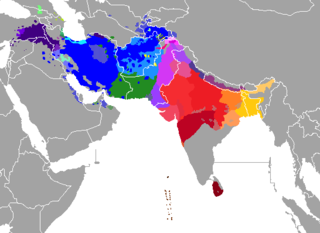Endomym
| | This section is empty. You can help by adding to it. (January 2023) |
| Brokskat | |
|---|---|
| Minaro | |
| Native to | India, Pakistan |
| Region | Ladakh, Baltistan |
| Ethnicity | Brokpa (Minaro) |
Native speakers | (about 3,000 cited 1996) [1] |
Indo-European
| |
| Tibetan script, Nastaliq script [ citation needed ] | |
| Language codes | |
| ISO 639-3 | bkk |
| Glottolog | brok1247 |
| ELP | Brokskat |
Brokskat (Tibetan : འབྲོག་སྐད་, Wylie : ’brog skad) [2] or Minaro [3] is an endangered Indo-Aryan language spoken by the Brokpa people in the lower Indus Valley of Ladakh, India and its surrounding areas. [1] [4]
It is an eastern Dardic language and the oldest surviving member of the ancient Dardic language. [5] It is considered a divergent variety of Shina, [6] but it is not mutually intelligible with the other dialects of Shina. [7] It is only spoken by 2,858 people in Ladakh and 400 people in the adjoining Baltistan, part of Pakistan-administered territory of Gilgit-Baltistan, within the larger disputed Kashmir region. [8]
| | This section is empty. You can help by adding to it. (January 2023) |
| English | Brokskat in Roman script | Brokskat in Bodyig script |
|---|---|---|
| Water | wa | ཝུའ་ |
| Fire | ghur | གཱུར |
| Sun | Suri | སུརིའ་ |
| Moon | gyun | གྱུན |
| Mountain | chur | ཆུར |
| Human | mush | མུཤ |
| Land | bun | བུན |
| Boy | byo | བྱོ |
| Girl | molay | མོལེའ་ |
| Baby | bubu | བུའབུའ |
| Knife | cutter | ཀཊའར |
| English | Brokskat -present tense | Brokskat-past tense | Broskat-future tense | Imperative |
|---|---|---|---|---|
| To go | byas | go | byungs | boyai |
| To stand | autheis | authait | authiyungs | authi |
| To Break | phitais | phitaiat | phitiaungs | phitai |
| To open | aunis | auniat | auniungs | auni |
| To laugh | hazis | hazit | haziungs | hazi |
| To sit | bazhais | bazhit | bazhiungs | bazhi |
| To walk | zazis | zazit | zaziungs | zazi |
| To throw | faitis | faitiat | fatiungs | fati |
| To look | skis | skait | skiungs | ski |
| Cut | chhinis | chinait | chhiniungs | chhini |
| To Count | gyanis | gyaniat | gyaniungs | gyani |

The Indo-Iranian languages constitute the largest and southeasternmost extant branch of the Indo-European language family. They include over 300 languages, spoken by around 1.5 billion speakers, predominantly in South Asia, West Asia and parts of Central Asia.

The Indo-Aryan languages are a branch of the Indo-Iranian languages in the Indo-European language family. As of the early 21st century, they have more than 800 million speakers, primarily concentrated in India, Pakistan, Sri Lanka, Bangladesh, Nepal and Maldives. Moreover, apart from the Indian subcontinent, large immigrant and expatriate Indo-Aryan–speaking communities live in Northwestern Europe, Western Asia, North America, the Caribbean, Southeast Africa, Polynesia and Australia, along with several million speakers of Romani languages primarily concentrated in Southeastern Europe. There are over 200 known Indo-Aryan languages.

Pakistan is a multilingual country with over 70 languages spoken as first languages. The majority of Pakistan's languages belong to the Indo-Iranian group of the Indo-European language family.

Balti is a Tibetic language natively spoken by the ethnic Balti people in the Baltistan region of Gilgit-Baltistan, Pakistan, Nubra Valley of the Leh district and in the Kargil district of Ladakh, India. The language differs from Standard Tibetan; many sounds of Old Tibetan that were lost in Standard Tibetan are retained in the Balti language. It also has a simple pitch accent system only in multi-syllabic words while Standard Tibetan has a complex and distinct pitch system that includes tone contour. Due to effects of dominant languages in Pakistani media like Urdu, Punjabi and English and religious impact of Arabic and Persian languages, Balti, like other regional languages of Pakistan, is continuously expanding its vocabulary base with loanwords.

The Dardic languages, or Hindu-Kush Indo-Aryan languages, are a group of several Indo-Aryan languages spoken in northern Pakistan, northwestern India and parts of northeastern Afghanistan. This region has sometimes been referred to as Dardistan.

Khowar, or Chitrali, is a Dardic language of Indo-Aryan language family primarily spoken in Chitral and surrounding areas in Pakistan.

Dameli (دَميلي), also Damia, Damɛ̃ḍī, Dāmia bāṣa or Gidoj, is an Indo-Aryan language of the Dardic subgroup spoken by approximately 5,000 people in the Domel Town, in the Chitral District of Khyber-Pakhtunkhwa province of Pakistan.

Gawar-Bati or Narsati is an Indo-Aryan language spoken in the Kunar, Nari of Eastern Afghanistan, and across the border in Pakistan, It is also known as Kohistani in Kunar. Gawar-Bati has estimated speakers of 75,000. 5,0000 of them are living in ,Kunar,Nari,Afghanistan and 25,000 of them are in Chitral, Pakistan.

Shina is a Dardic language of Indo-Aryan language family spoken by the Shina people. In Pakistan, Shina is the major language in Gilgit-Baltistan spoken by an estimated 1,146,000 people living mainly in Gilgit-Baltistan and Kohistan. A small community of Shina speakers is also found in India, in the Guraiz valley of Jammu and Kashmirdistrict anantnag and in Dras valley of Ladakh.
The Middle Indo-Aryan languages are a historical group of languages of the Indo-Aryan family. They are the descendants of Old Indo-Aryan and the predecessors of the modern Indo-Aryan languages, such as Hindustani (Hindi-Urdu), Bengali and Punjabi.
Dawoodi, also known as Domaakí, Ḍumāki, or Domaá, is an endangered Indo-Aryan language spoken by a few hundred people living in the Gilgit-Baltistan territory in northern Pakistan. It is historically related to the Central Indo-Aryan languages of the Indian Midlands, though it has been significantly influenced by its neighbours.
Magadhi Prakrit (Māgadhī) is of one of the three Dramatic Prakrits, the written languages of Ancient India following the decline of Pali and Sanskrit. It was a vernacular Middle Indo-Aryan language, replacing earlier Vedic Sanskrit.

The Brokpa, sometimes referred to as Minaro, are a small ethnic group mostly found in the union territory of Ladakh, India around the villages of Dha and Hanu. Some of the community are also located across the Line of Control in Baltistan in the villages around Ganokh. They speak an Indo-Aryan language called Brokskat. The Brokpa are mostly Vajrayana Buddhist while some are Muslim.

Indus Kohistani or simply Kohistani is an Indo-Aryan language spoken in the former Kohistan District of Pakistan. The language was referred to as Maiyã (Mayon) or Shuthun by early researchers, but subsequent observations have not verified that these names are known locally.

The Shina or Gilgitis are an Indo-Aryan ethnolinguistic group primarily residing in Gilgit–Baltistan and Indus Kohistan in Pakistan, as well as in the Dras Valley and Kishenganga Valley (Gurez) in the northern region of Jammu and Kashmir and Ladakh in India. They speak an Indo-Aryan language, called Shina and their geographic area of predominance is referred to as Shenaki.
Tirahi is a nearly extinct if not already extinct Indo-Aryan language spoken in a few villages in the southeast of Jalalabad in the Nangarhar Province of eastern Afghanistan. It is spoken by older adults, who are likewise fluent in Pashto.

Indus Kohistanis are an Indo-Aryan ethnolinguistic group speaking the Indus Kohistani language. They mainly reside in Indus Kohistan, Hazara Division in northern Pakistan.
Kohistani Shina is an Indo-Aryan language spoken in the former Kohistan District of Khyber Pakhtunkhwa, northern Pakistan. According to Ethnologue, Kohistani Shina is mutually intelligible with the Shina variety of Chilas, but not with the standard dialect of Gilgit. Bateri and Kalkoti speakers speak Kohistani Shina as a second language. Indus Kohistani loanwords can be found in the language. A grammar and a dictionary of the language have been published.

Aryan Valley, historically known as Dah Hanu region, is an area comprising four village clusters — Dah and Hanu in Leh district, and Garkon and Darchik in Kargil district — in Central Ladakh in India. It is inhabited by Brokpa people of Dardic origin. Until its absorption into the Maryul kingdom, Brokpa chiefs wielded nominal autonomy in the region.

Brokpa, Drokpa, Dard and Shin is a category of Scheduled Tribes under the Indian constitution.
The mother tongue of the Brokpa is Minaro, an Indo–Aryan language, though their vocabulary heavily borrows from Ladakhi.
Minaro is an alternate ethnic name. "Brokpa" is the name given by the Ladakhi for the people. "Brokskat" is the language.
Brokskat' is the language. This is the oldest surviving member of the ancient Dardic language.
A very divergent variety of Shina
{{cite book}}: CS1 maint: others (link)And is not mutually intelligible with the other shina language